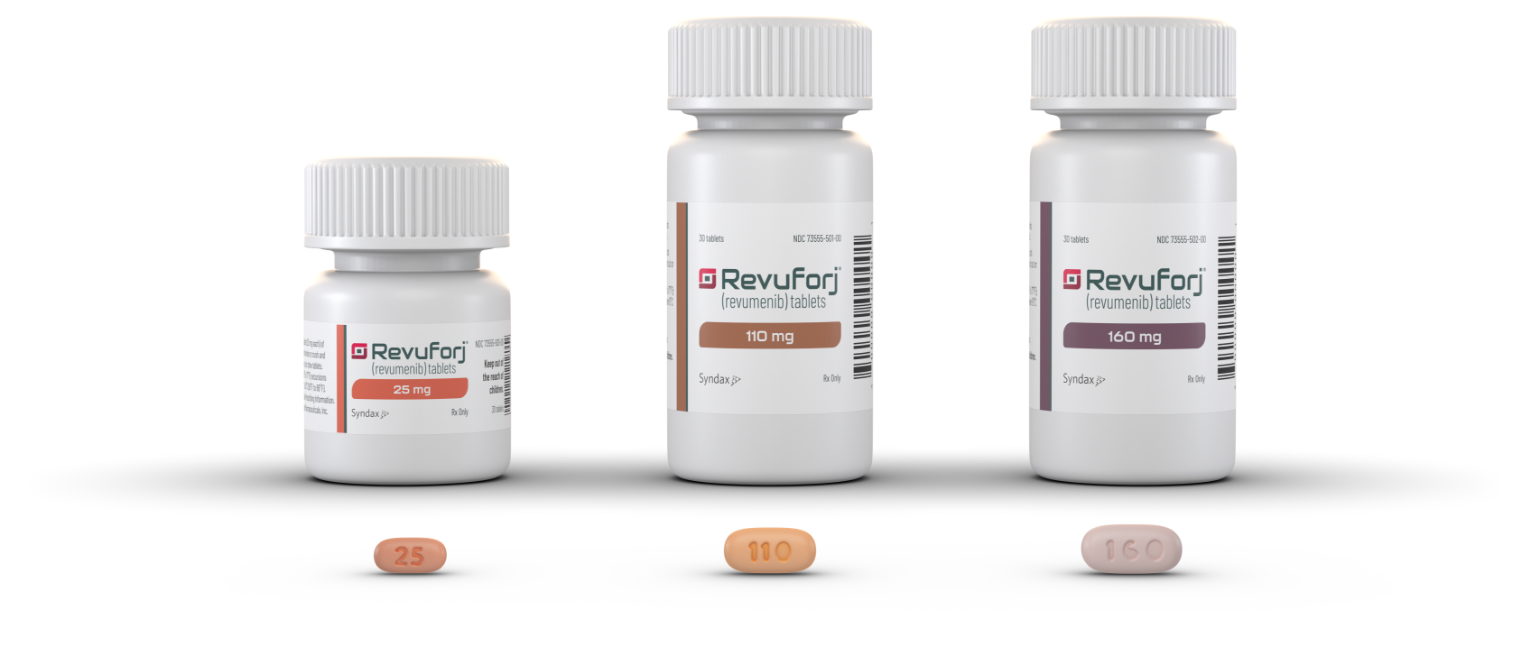WARNINGS AND PRECAUTIONS
Differentiation syndrome: Revuforj can cause fatal or life-threatening differentiation syndrome (DS). Symptoms of DS, including those seen in patients treated with Revuforj, include fever, dyspnea, hypoxia, peripheral edema, pleuropericardial effusion, acute renal failure, and/or hypotension. In clinical trials, DS occurred in 39 (29%) of 135 patients treated with Revuforj. DS was Grade 3 or 4 in 13% of patients and fatal in one. The median time to onset was 10 days (range 3-41 days). Some patients experienced more than 1 DS event. Treatment interruption was required for 7% of patients, and treatment was withdrawn for 1%.
Reduce the white blood cell count to less than 25 Gi/L prior to starting Revuforj. If DS is suspected, immediately initiate treatment with systemic corticosteroids (e.g., dexamethasone 10-mg IV every 12 hours in adults or dexamethasone 0.25-mg/kg/dose IV every 12 hours in pediatric patients weighing less than 40 kg) for a minimum of 3 days and until resolution of signs and symptoms. Institute supportive measures and hemodynamic monitoring until improvement. Interrupt Revuforj if severe signs and/or symptoms persist for more than 48 hours after initiation of systemic corticosteroids, or earlier if life-threatening symptoms occur such as pulmonary symptoms requiring ventilator support. Restart steroids promptly if DS recurs after tapering corticosteroids.
QTc interval prolongation: In the clinical trials, QTc interval prolongation was reported as an adverse reaction in 39 (29%) of 135 patients treated with Revuforj. QTc interval prolongation was Grade 3 in 12% of patients. The heart-rate corrected QT interval (using Fridericia’s method) (QTcF) was greater than 500 msec in 8%, and the increase from baseline QTcF was greater than 60 msec in 18%. Revuforj dose reduction was required for 5% of patients due to QTc interval prolongation. QTc prolongation occurred in 16% of the 31 patients less than 17 years old, 33% of the 88 patients 17 years to less than 65 years old, and in 50% of the 16 patients 65 years or older.
Correct electrolyte abnormalities, including hypokalemia and hypomagnesemia, prior to treatment with Revuforj. Perform an electrocardiogram (ECG) prior to initiation of Revuforj, and do not initiate Revuforj in patients with QTcF >450 msec. Perform an ECG at least once weekly for the first 4 weeks and at least monthly thereafter. In patients with congenital long QTc syndrome, congestive heart failure, electrolyte abnormalities, or those who are taking medications known to prolong the QTc interval, more frequent ECG monitoring may be necessary. Concomitant use with drugs known to prolong the QTc interval may increase the risk of QTc interval prolongation.
-
Interrupt Revuforj if QTcF increases >480 msec and <500 msec, and restart Revuforj at the same dose twice daily after the QTcF interval returns to ≤480 msec
-
Interrupt Revuforj if QTcF increases >500 msec or by >60 msec from baseline, and restart Revuforj twice daily at the lower-dose level after the QTcF interval returns to ≤480 msec
-
Permanently discontinue Revuforj in patients with ventricular arrhythmias and in those who develop QTc interval prolongation with signs or symptoms of life-threatening arrhythmia
Embryo-fetal toxicity: Revuforj can cause fetal harm when administered to a pregnant woman. Advise pregnant women of the potential risk to a fetus. Advise females of reproductive potential and males with female partners of reproductive potential to use effective contraception during treatment with Revuforj and for 4 months after the last dose of Revuforj.
ADVERSE REACTIONS
Fatal adverse reactions occurred in 4 (3%) patients who received Revuforj, including 2 with differentiation syndrome, 1 with hemorrhage, and 1 with sudden death.
Serious adverse reactions were reported in 99 (73%) patients. The most frequent serious adverse reactions (≥5%) were infection (24%), febrile neutropenia (19%), bacterial infection (17%), differentiation syndrome (12%), hemorrhage (9%), and thrombosis (5%).
The most common adverse reactions (≥20%) including laboratory abnormalities, were hemorrhage (53%), nausea (51%), phosphate increased (50%), musculoskeletal pain (42%), infection (41%), aspartate aminotransferase increased (37%), febrile neutropenia (35%), alanine aminotransferase increased (33%), parathyroid hormone intact increased (33%), bacterial infection (31%), diarrhea (30%), differentiation syndrome (29%), electrocardiogram QT prolonged (29%), phosphate decreased (25%), triglycerides increased (25%), potassium decreased (24%), decreased appetite (24%), constipation (23%), edema (23%), viral infection (23%), fatigue (22%), and alkaline phosphatase increased (21%).
DRUG INTERACTIONS
Drug interactions can occur when Revuforj is concomitantly used with:
-
Strong CYP3A4 inhibitors: reduce Revuforj dose
-
Strong or moderate CYP3A4 inducers: avoid concomitant use with Revuforj
-
QTc-prolonging drugs: avoid concomitant use with Revuforj. If concomitant use is unavoidable, obtain ECGs when initiating, during concomitant use, and as clinically indicated. Withhold Revuforj if the QTc interval is >480 msec.
Restart Revuforj after the QTc interval returns to ≤480 msec
SPECIAL POPULATIONS
Lactation: advise lactating women not to breastfeed during treatment with Revuforj and for 1 week after the last dose.
Pregnancy and testing: Revuforj can cause fetal harm when administered to a pregnant woman. Verify pregnancy status in females of reproductive potential within 7 days prior to initiating Revuforj.
Pediatric: monitor bone growth and development in pediatric patients.
Geriatric: compared to younger patients, the incidences of QTc prolongation and edema were higher in patients 65 years and older.
Infertility: based on findings in animals, Revuforj may impair fertility. The effects on fertility were reversible.
To report SUSPECTED ADVERSE REACTIONS, contact Syndax Pharmaceuticals at 1-888-539-3REV or FDA at 1-800-FDA-1088
or www.fda.gov/medwatch.
INDICATION
Revuforj® (revumenib) is a menin inhibitor indicated for the treatment of relapsed or refractory acute leukemia with a lysine methyltransferase 2A gene (KMT2A) translocation in adult and pediatric patients 1 year and older.
Please see Full Prescribing Information, including BOXED WARNING.






